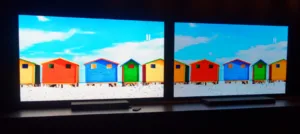
We’re back from CES and have been frantically trying to catch up – it seems that the rest of the world doesn’t stop just because the technology press and channels are in Las Vegas! This is a very busy period of the year for us, with BETT, the UK education show that is important for seeing trends in interactive displays, and then ISE.
We are splitting the CES issue this year, with one section exclusively devoted to TV and the second half covering ‘everything else’. Even with four of us, there were still items and companies that we missed, but we think we have some interesting material for you.
Before the show, I highlighted that I expected a big reaction from Samsung to the success that LG has had with OLED. At the show, Samsung showed its Wall display, but I don’t expect that to be more than a headline product – it’s way too big for most people (at the moment) and will be seriously expensive, I think. More interesting was the closed ‘Innovation Zone’ at the back of the Samsung booth.
Along with two colleagues, Chris and Ken, I was able to get a full hour with Samsung’s engineers in the private suite, where Calman/Portrait Displays and our friend and occasional Display Daily contributor, Florian Friedrich were showing some of the quality of the latest Samsung sets. The company showed us what is developing using quantum dot technology, especially a direct lit LCD TV set that has a very high number of ‘zones’ to adjust the backlight. The high number of zones and latest control system ensure that there are no ‘halo’ areas around highlights around HDR highlights.
Once that problem is solved and with a great black level, the strong performance of the LCDs came into its own. As we saw when Eizo showed its stunning broadcast monitor in comparison to the Sony OLED at IBC, Samsung was able to show how the LCD retained its colour performance even with bright highlights, whereas the OLED lost saturation. This is the issue of ‘colour volume’ that is behind Epson’s CLO measurement system in projection. It took me a while to get on board with that concept, but it is important, I think. It’s only the second time that I have seen a side by side of an LCD and an OLED where the LCD looked better.
The Samsung TV in the Innovation zone also has some special black enhancement technology that also improves contrast at different viewing angles. The company wouldn’t allow us to show the slide with the illustration, but the approach looks, to me, similar in some ways to the louvre system used in outdoor LED displays to boost contrast. There are black protrusions that stop light leakage between pixels and also absorb ambient light hitting the pixel. Above the protrusion is a microlens that spreads the light, improving the viewing angle of Samsung’s VA panel dramatically.
The sets in the Innovation zone looked even better than this one shown at the “Early look”. Image:Meko
Also at the show, Nvidia’s BFGD for gaming was being shown. This uses a fast AUO panel and is intended for gaming. I couldn’t really believe how good the speed response was, with no apparent blurring between frames, even at high refresh rates. As Chris has written, the Sony 10,000 cd/m² TV also showed how bright LCD could be.
It really is astonishing how LCD technology has been developed that is conquering all of the challenges in visual quality. The astonishing performance from this technology in providing stunning images would not have been imaginable when LCDs first hit the market!
One of the sayings that came up this year is the idea “Don’t bet against the engineers”. I can’t remember when I first heard that phrase, or who said it, but it’s one worth bearing in mind! I keep thinking about it when I think of the huge challenges in AR, which I still expect to be a huge opportunity for the future. At CES, we saw microdisplays that can create the images. Now we just need the engineers to solve the optics issues! I wouldn’t bet against the engineers finding a solution to this challenge!
Bob

